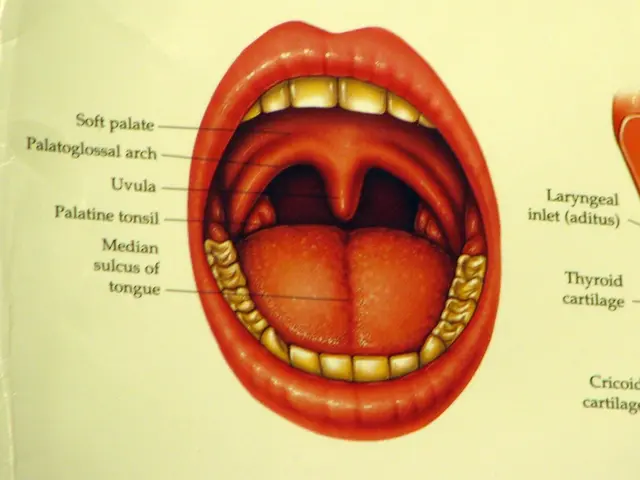Connection and Risk Factors Between Breast and Ovarian Cancer: Examination and Causes
Take a load off and grab a cuppa, 'cause we're delving into the nitty-gritty connection between breast and ovarian cancer, two pesky ladies you never want to meet. They're closer than you think – genetically, that is – and if you're running in the fam, you might want to read up on this.
The deal's sealed with genetic factors. BRCA1 and BRCA2 mutations are the prime suspects in the criminal enterprise of breast and ovarian cancers among those who carry them. It's a dangerous duo that often targets families linked to these horrid diseases.
But these cancers share other dirty secrets too, like overweight or obesity, older age, and never carrying a bun in the oven. Some of these factors might be under your control, so being informed could help you make smart decisions that keep these cancer-causing influences at bay.
Now, here's the lowdown on whether breast and ovarian cancers give each other a helping hand:
As it turns out, if you've got breast cancer, your risk of developing ovarian cancer could be bumped up. This is particularly true if your breast cancer has anything to do with genetic mutations in BRCA1 or BRCA2. But remember, it's those genetic mutations calling the shots, not the cancer itself.
Dive into the research, and you'll find that folks with breast cancer are twice as likely to develop ovarian cancer again. And for those battling ovarian cancer, their odds for breast cancer go up by 1.6 times, although timing plays a crucial role.
Reversely, ovarian cancer begets a higher risk of breast cancer too, a risk that may stem from those pesky genetic mutations again.
Other Risk Factors for Breast and Ovarian Cancers
The BRCA1 and BRCA2 genes are the big cheeses when it comes to shared genetic risk factors. It's estimated that around 65% of families with ovarian and breast cancer have BRCA1 mutations, and about 20% have BRCA2 mutations.
A family history of either cancer, older age, being overweight or obese, having your first child over 30, never having kids, not breastfeeding, hormone therapy after menopause – all these factors play a part in increasing the risk of both cancers.
Can You Lower the Risk of Breast and Ovarian Cancers?
There are some risk factors that are beyond your control, like your family history or having had breast or ovarian cancer before. But with these unchangeable risks, you can still take charge by keeping a close eye, making smart lifestyle choices, and working with your doc on preventative measures.
If you fit into the high-risk category – thanks to a history of breast or ovarian cancer or genetic mutations – your healthcare team might suggest more frequent and detailed screenings. This might include mammograms, MRI scans, pelvic exams, transvaginal ultrasounds, and CA-125 blood tests to catch any new nasties early.
Genetic testing for BRCA1, BRCA2, and other relevant mutations can also help you and your doc develop the best game plan for monitoring and prevention. In severe cases, doctors might even consider prophylactic surgeries to minimize risk.
Changeable Risk Factors
There's some good news: not all risk factors are unchangeable. Here's where you can make a difference:
- Maintain a healthy weight: Sticking to a moderate weight can help reduce the risk of breast and ovarian cancer. Obesity might cause hormonal imbalances that boost the risk of breast cancer.
- Exercise regularly: Regular exercise has been linked to a reduced risk of breast cancer, and there's limited evidence supporting a link between exercise and ovarian cancer. Exercise might also have direct anticancer effects.
- Moderate alcohol intake: Cutting back on booze can help lower the risk of breast cancer. The more alcohol you drink, the higher your risk, so keep it casual.
- Consider oral contraceptives: Oral contraceptives may decrease the risk of ovarian cancer. However, they might slightly increase the risk of breast cancer. Your doc can help you weigh the risks based on your specific circumstances.
Outlook
A 2020 study suggests that folks with both primary breast cancer and primary ovarian cancer have a relatively optimistic prognosis, with 5- and 10-year overall survival rates of about 90%.
The outlook is generally brighter when the gap between the two diagnoses is greater. However, ovarian cancer that follows breast cancer is often discovered at a later stage, which can make things tricky.
Your age during your first diagnosis and the time between the two diagnoses are critical in predicting overall survival. If you've got questions about your personal prognosis, don't hesitate to ask your medical team.
When to Talk to a Doc
If you see any signs or symptoms of breast or ovarian cancer, especially if there's a family history, it's essential to have a chat with your doc ASAP. Keep a watchful eye for any recurrences or second cancers after a previous diagnosis.
Early detection and swift treatment can make a world of difference in terms of outcomes.
Cancer Resources
Looking for more reliable, evidence-based information and resources on cancer? Pop by our dedicated hub to satiate your thirst for knowledge!
FAQs
- Can ovarian cancer increase the risk of certain other cancers? Yes, ovarian cancer can raise the risk for several types of cancer, including breast, bladder, bile duct, colorectal, acute leukemia, and melanoma of the eye.
- Can breast cancer spread to the ovaries? While it's less common, breast cancer can metastasize to the ovaries, particularly in those with advanced breast cancer and hormone-receptor-positive tumors.
- Who has a higher risk of ovarian cancer? High-risk folks typically include those with BRCA1 or BRCA2 gene mutations, a family history of ovarian, breast, or colorectal cancer, Lynch syndrome, endometriosis, never having been pregnant, having a late first pregnancy, and being age 40 or older.
Summary
The relationship between breast and ovarian cancer is deeper than you might think, primarily due to shared genetic mutations in BRCA1 and BRCA2 genes. Those with these mutations take on a significant risk of developing both cancers.
Besides BRCA mutations, several other genetic, familial, and environmental factors contribute to the risk of both cancers. By keeping tabs on your risk factors and making well-informed lifestyle choices, you can help decrease your odds of breast and ovarian cancers.
- Genetic mutations in BRCA1 and BRCA2 genes significantly increase the risk of both breast and ovarian cancers.
- People with breast cancer have a higher risk of developing ovarian cancer, with those with genetic mutations being particular at risk.
- Conversely, ovarian cancer can also increase the risk of breast cancer, again due to genetic mutations.
- Besides genetic factors, other risk factors for breast and ovarian cancers include family history, older age, being overweight or obese, having first child over 30, never having kids, not breastfeeding, and hormone therapy after menopause.
- Healthy lifestyle choices such as maintaining a healthy weight, regular exercise, moderate alcohol intake, and oral contraceptives can help lower the risk of breast and ovarian cancers.
- Genetic testing for BRCA1, BRCA2, and other relevant mutations can provide valuable information for monitoring and prevention strategies, and in some severe cases, prophylactic surgeries may be considered.
- Early detection and swift treatment are crucial for favorable outcomes in cases of breast and ovarian cancers.
- Ovarian cancer can raise the risk for several other types of cancer, including breast, bladder, bile duct, colorectal, acute leukemia, and melanoma of the eye.








